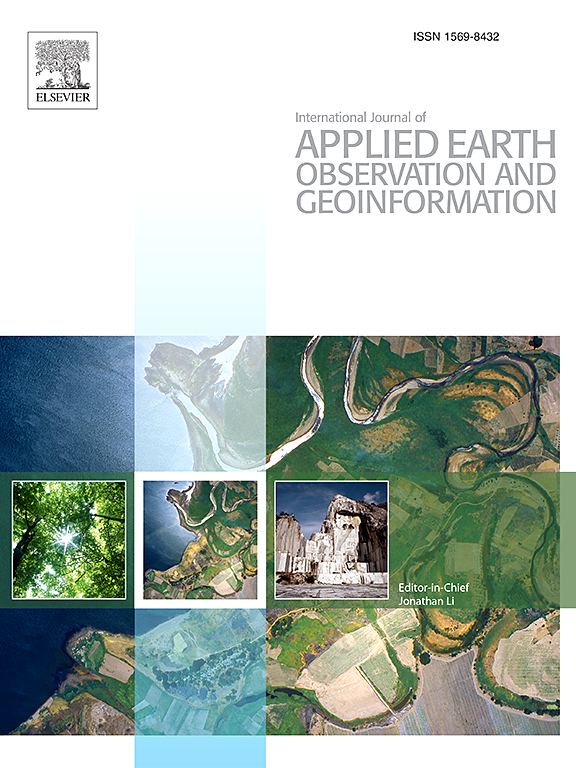ESMII-Net: An edge-synergy and multidimensional information interaction network for remote sensing change detection
IF 7.6
Q1 REMOTE SENSING
International journal of applied earth observation and geoinformation : ITC journal
Pub Date : 2025-04-08
DOI:10.1016/j.jag.2025.104507
引用次数: 0
Abstract
In recent advancements, deep learning-based methods for change detection have demonstrated rapid capabilities to identify alterations across extensive regions, underscoring significant research and application potential in remote sensing change detection. Nonetheless, these methods currently encounter limitations in feature extraction, often leading to blurred edges and challenges in identifying small-scale changes. To overcome these challenges, we introduce the Edge-Synergy and Multidimensional Information Interaction Network (ESMII-Net) specifically designed for remote sensing change detection. We achieve feature enhancement through the Multidimensional Information Interaction Fusion Module (MIIFM) and, by integrating the edge aware decoder and the Edge-Synergy Module (ESM), guide the model to acquire effective edge information, thereby improving change detection performance. Furthermore, during the loss function formulation, we have incorporated a Small Object Enhancement Factor (SOEF) to prioritize small object detection. An edge-awareness map is also utilized within the model to accurately delineate change edges and assess their influence on adjacent changed pixels. The efficacy of our model and its innovative components has been validated through experimental results on two public datasets, showcasing improved capabilities in detecting edges and small objects.
ESMII-Net:面向遥感变化检测的边缘协同和多维信息交互网络
在最近的进展中,基于深度学习的变化检测方法已经显示出快速识别广泛区域变化的能力,强调了遥感变化检测的重要研究和应用潜力。然而,这些方法目前在特征提取方面存在局限性,经常导致边缘模糊,并且在识别小尺度变化方面存在挑战。为了克服这些挑战,我们引入了专门为遥感变化检测设计的边缘协同和多维信息交互网络(ESMII-Net)。我们通过多维信息交互融合模块(MIIFM)实现特征增强,并通过集成边缘感知解码器和边缘协同模块(ESM),引导模型获取有效的边缘信息,从而提高变化检测性能。此外,在损失函数的制定过程中,我们引入了小目标增强因子(SOEF)来优先考虑小目标检测。在模型内还利用边缘感知图来准确描绘变化边缘并评估其对相邻变化像素的影响。我们的模型及其创新组件的有效性已经通过两个公共数据集的实验结果得到验证,展示了改进的边缘和小物体检测能力。
本文章由计算机程序翻译,如有差异,请以英文原文为准。
求助全文
约1分钟内获得全文
求助全文
来源期刊

International journal of applied earth observation and geoinformation : ITC journal
Global and Planetary Change, Management, Monitoring, Policy and Law, Earth-Surface Processes, Computers in Earth Sciences
CiteScore
12.00
自引率
0.00%
发文量
0
审稿时长
77 days
期刊介绍:
The International Journal of Applied Earth Observation and Geoinformation publishes original papers that utilize earth observation data for natural resource and environmental inventory and management. These data primarily originate from remote sensing platforms, including satellites and aircraft, supplemented by surface and subsurface measurements. Addressing natural resources such as forests, agricultural land, soils, and water, as well as environmental concerns like biodiversity, land degradation, and hazards, the journal explores conceptual and data-driven approaches. It covers geoinformation themes like capturing, databasing, visualization, interpretation, data quality, and spatial uncertainty.
 求助内容:
求助内容: 应助结果提醒方式:
应助结果提醒方式:


